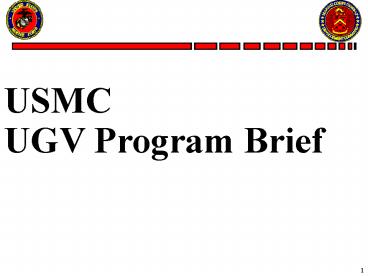Unmanned Ground Vehicles - PowerPoint PPT Presentation
1 / 21
Title:
Unmanned Ground Vehicles
Description:
FY02/03 - Award up to four Preliminary Design/Technology Development contracts ... 4-wheel, rear-wheel drive, front-wheel steer. Goal weight of 8 lbs (vehicle) ... – PowerPoint PPT presentation
Number of Views:285
Avg rating:3.0/5.0
Title: Unmanned Ground Vehicles
1
USMC UGV Program Brief
2
Assault Breacher Vehicle
3
Assault Breacher Vehicle
- ABV is a tracked, engineering vehicle designed to
breach minefields and complex obstacles and
provide in-stride breaching capability. - Based on the M1A1 MBT chassis, the ABV will
provide the latest technology in crew protection
and vehicle survivability, while having the speed
and mobility to keep pace with the maneuver
force. - ABV equipment includes
- Full-Width Mine Plow
- Two Mk 155 Linear Demolition Charges
- Lane Marker System
- Twin .50 Caliber Machine Guns
4
ABV Components
5
GLADIATORTactical Unmanned Ground Vehicle
6
System Description
- The Gladiator is a robust, compact, multi-purpose
UGV system, consisting of three major subsystems - Highly mobile and survivable Mobility Base Unit
- Day and Night Video Cameras
- GPS
- Laser Rangefinder
- Acoustic Detection System
- Interchangeable Mission Payload Modules
- Man wearable, hand held Operator Control Unit
7
Gladiator Missions
- RSTA/Scouting
- Obstacle Breaching
- Direct Fire
- NBC Reconaissance
- Possess Ability to Employ Future Mission Modules
- obscurant delivery
- direct fire (lethal and non-lethal)
- communications relay
- engineer reconnaissance
- tactical deception
- counter sniper employment
8
Benefits of the Gladiator
- Enhance ability of tactical commanders to rapidly
detect, identify, locate, and neutralize a
variety of threats. - Provide commanders with additional time and space
with which to effectively make decisions and
execute plans. - Increase force survivability and reduce attrition
of Marine Corps personnel by remoting combat
tasks. - Maximize Economy of Force efforts through the
conservation of personnel and reduction of risks.
9
AO FNC Objectives
- Enhance the mission capability of Naval Forces
by developing technologies that will dramatically
increase the autonomy, performance and
affordability of Naval organic unmanned vehicle
systems.
10
UGV Objectives
- Develop technologies that address capability gaps
in robotic command and control, mobility,
survivability, modularity, signature reduction,
navigation. - Perform demonstrations utilizing these
technologies to enhance the ability of tactical
commanders to rapidly detect, identify, and
remotely neutralize a variety of threats. - Transition these technologies to the Marine
Corps Gladiator Tactical Unmanned Ground Vehicle
Program.
11
Approach
- November 01 Release BAA
- FY02-04 Jointly fund design, technology
development, and demonstrations - ONR/OSD JRP - FY02/03 - Award up to four Preliminary
Design/Technology Development contracts for 12
months - FY03/04 - Downselect to up to 2 KTRs for
Detailed Design and Hardware Demonstration phase
for 15 months - FY04/05 Transition to UGV/S JPO for SDD Phase
12
EOD Robotic System
- Abbreviated Acquisition Program
- Man Transportable System that will be employed by
MAGTF EOD Dets and base EOD personnel. - Performance Objectives
- Ability to Travel in Decimated Urban Areas
- Disrupter
- Manipulating Arm
- NBC Detection Capability
13
DRAGON RUNNER
MCWL NRL - CMU
Hagen Schempf Carnegie Mellon University Robotics
Institute hagen_at_rec.ri.cmu.edu (Chassis
design)
Capt David Moreau Warfighting Lab moreaudm_at_mcwl. q
uantico.usmc.mil (Project Officer)
Marine Corps Mobile Ground Sensor
Larry Schuette Naval Research Laboratory schuette_at_
nrl.navy.mil (GCS /User Interface design)
14
Primary Goal
DRAGON RUNNER
- Develop a mobile ground sensor capability that
will be employed at the platoon/squad level
within the GCE. - Maintain a small footprint
- UGV must fit within the MOLLE Assault Pack.
- OCU must fit within a MOLLE SAW pouch.
- Durability (to be thrown up/down stairs and
over/around walls).
Primary Challenges
15
Expected benefits to the Marine Rifle Platoon
DRAGON RUNNER
- Elevate situational awareness/extending the limit
of human observation (around the corner
capability). - Provide a limited, tactical, force protection
capability (sentry mode). - Provide a man-portable system that will provide
observational coverage in confined areas where
human access is impractical or unsustainable. - Increase real-time feedback.
16
System Overview
- System Features
- 4-wheel, rear-wheel drive, front-wheel steer
- Goal weight of 8 lbs (vehicle)
- L 12-14 x W 8 x H 4
- Low Light Level wide angle video camera with IR
LEDs for night use - Sensor pods for sentry mode
- Earpiece for audible alert during sensor mode
- 2-sided suspension for inverted ops
- Foldable handle for throwing
- Mission Capabilities
- 2-hr. drive mode/12 hr. sentry mode using
standard 5590 / 390 batteries - Computer-assisted obstacle avoidance
- Anti-Tampering program
- Remote compact OCU utilizing military freqs
- Back-Track capability
- NO stairs, rough terrain, ladders, ropes,
cliffs, trees
17
DRAGON RUNNER
Schedule for FY02
- Control software design/tests (NRL / MCWL Bldg)
- MOUT/Quantico LTA (Jan 4, 02)
- Modifications/improvements (Post MOUT)
- GCS design
- Detailed Vehicle design
- Subsystem development with prototype RC model
- Integration chassis subsystems
- Millennium Dragon (July 02) Experimentation
- Modifications/improvements (Post MC)
18
Wearable Operator Control UnitSBIR
- Currently in Phase II.
- Objective
- Design a practical operator control unit (OCU)
for small UGV systems that will have minimal
impact upon the load carried by Marines. The
wearable OCU will allow the operator to remain
free to perform other battle tasks while
operating the UGV system.
From this...
to this and beyond.
19
Wireless RF DatalinkSBIR
- Phase 1 Selection Complete
- Goal To develop a wireless RF datalink for
small UGVs that optimizes performance in enclosed
spaces and urban environments. - Status Phase 1 Contract Award anticipated in
this month. - Upcoming Phase 1 Kick-Off meeting after
contract award.
20
Questions?
21
Point of Contact
- Robert Parks
- (703) 784-6209
- DSN 278-6209
- parksrs_at_mccdc.usmc.mil































